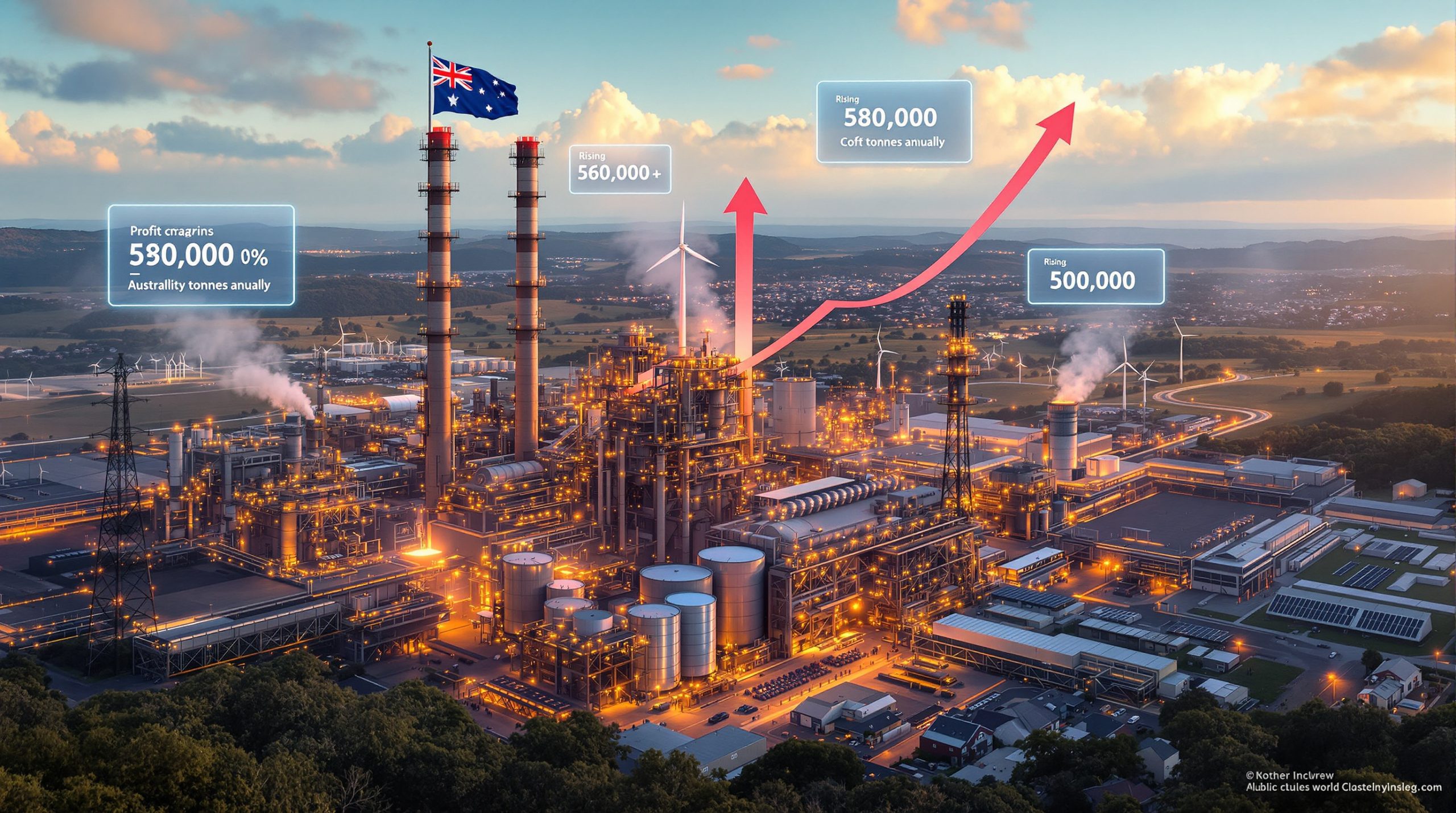Rio Tinto operates as one of the world's largest mining companies, with diversified operations spanning iron ore, copper, and aluminium production. This commodity portfolio creates multiple revenue streams that can support dividend distributions even when individual markets face challenges. The Rio Tinto dividend forecast 2026 suggests particularly attractive returns for income-focused investors.
The company's iron ore operations, primarily located in Australia's Pilbara region, generate the majority of its cash flows. These operations benefit from proximity to major Asian markets, particularly China, which consumes approximately 70% of global seaborne iron ore supply. Furthermore, when iron ore price trends remain elevated, as they currently sit around US$109 per tonne, Rio Tinto's profitability increases substantially, directly supporting higher dividend payments.
Mining Operations Driving 2026 Income Potential
Rio Tinto's copper portfolio includes the significant Oyu Tolgoi mine in Mongolia, which continues ramping up production successfully. Copper prices have strengthened due to growing demand from renewable energy infrastructure and electric vehicle manufacturing, creating additional support for the company's earnings profile. Moreover, copper market insights suggest continued strength in this sector.
The aluminium operations provide further diversification, though these typically generate lower margins compared to iron ore and copper. This three-pillar approach reduces Rio Tinto's dependence on any single commodity, creating more stable cash flow generation across different market cycles.
Historical Dividend Consistency
Rio Tinto has maintained dividend payments through various commodity cycles, demonstrating the company's commitment to shareholder returns. The semi-annual distribution schedule provides investors with regular income flows, typically paid in March and September each year.
This payment structure allows investors to plan their cash flow requirements while benefiting from the company's earnings throughout the year. Additionally, the consistency becomes particularly valuable during volatile market periods when other income sources may fluctuate significantly.
Analyst Projections Point to Substantial 2026 Returns
UBS analysts project Rio Tinto will deliver significantly higher dividend payments in FY26, with forecasts suggesting annual dividends per share of US$5.15, representing a 29.7% increase from the projected FY25 payout of US$3.97 per share.
These projections assume Rio Tinto will generate approximately US$13.2 billion in net profit after tax on revenues of US$59.1 billion during FY26. The forecasted dividend represents a payout ratio of 64%, slightly above the company's typical 40-60% policy range but still within reasonable bounds given the strong earnings outlook.
Income Calculations for Australian Investors
For Australian tax residents investing A$10,000 in Rio Tinto shares, the projected 8.5% grossed-up dividend yield could generate approximately A$850 in annual dividend income, including the benefit of franking credits.
This calculation assumes:
- Full franking credits attached to dividends
- Australian corporate tax rate of 30%
- Current share price levels maintained
- Successful delivery of UBS's earnings forecasts
The semi-annual payment structure would provide approximately A$425 per distribution, offering regular income flow for investors seeking passive income from their equity investments.
Franking Credit Benefits Enhance Returns
Australian investors receive additional value through franking credits, which represent tax already paid by Rio Tinto on profits distributed as dividends. For investors in lower tax brackets, these credits can provide cash refunds when lodging annual tax returns.
Consequently, the franking system effectively increases the after-tax return for Australian investors compared to international shareholders, making Rio Tinto particularly attractive for domestic dividend-focused portfolios.
Key Factors Supporting 2026 Dividend Expectations
Several operational and market factors underpin the optimistic dividend projections for Rio Tinto in 2026, with iron ore pricing dynamics playing the central role in determining actual outcomes. Iron ore demand insights further support these projections.
Iron Ore Market Dynamics Create Upside Potential
Current iron ore spot prices of approximately US$109 per tonne provide strong support for Rio Tinto's profitability. UBS analysts expect prices to maintain levels above US$100 per tonne over the next six to nine months before moderating toward cost support levels around US$90 per tonne.
This pricing outlook suggests Rio Tinto will continue generating substantial cash flows through 2026, even accounting for some price moderation in the latter part of the forecast period. However, the company's low-cost operations in the Pilbara region remain profitable at iron ore prices well below current levels.
Chinese steel production continues driving global iron ore demand, though infrastructure stimulus policies and property sector dynamics create some uncertainty around medium-term consumption patterns. Nevertheless, ongoing urbanisation and industrial development suggest continued baseline demand for steel-making raw materials.
Simandou Project Adds Production Capacity
The Simandou iron ore project in Guinea represents one of the mining industry's most significant developments, with first shipments scheduled for November 2025. This giant African project will add substantial production capacity to Rio Tinto's portfolio during 2026-2027.
UBS analysts note that ore began moving down the rail to the port in October 2025, indicating the project timeline remains on track. Furthermore, the successful ramp-up of Simandou will provide additional revenue streams supporting dividend growth, though increased global iron ore supply could create some pricing pressure.
The project's high-grade ore deposits and strategic location for Asian markets position it as a valuable long-term asset for Rio Tinto's dividend-paying capability.
Copper Operations Expansion Supports Diversification
The Oyu Tolgoi copper mine in Mongolia continues its successful production ramp-up, providing Rio Tinto with exposure to strengthening copper markets. Rising copper prices, driven by renewable energy and electrification trends, support improved profitability from these operations.
However, regulatory uncertainties around potential changes to mining licenses create some operational risks. UBS analysts specifically highlighted concerns about "the potential change in the mine plan to the transfer of entree licences," which could impact future production timelines.
Despite these regulatory challenges, copper's fundamental demand outlook remains strong due to the global energy transition requiring substantial copper infrastructure investment.
Understanding Rio Tinto's Dividend Framework
Rio Tinto operates under a flexible dividend policy targeting payout ratios between 40-60% of underlying earnings over commodity cycles. This framework allows the company to maintain dividend payments during market downturns while returning excess cash during strong commodity price periods.
Payout Ratio Flexibility Enables Consistency
The 40-60% target range provides Rio Tinto's management team with discretion to adjust dividend payments based on market conditions and capital allocation priorities. During commodity booms, payout ratios may exceed 60%, as projected for FY26 with the 64% forecast ratio.
This flexibility proves particularly valuable during volatile commodity cycles, allowing Rio Tinto to maintain dividend payments when earnings temporarily decline while preserving financial strength for future growth investments. In addition, the policy focuses on underlying earnings rather than statutory profits, removing the impact of one-off items and providing more consistent dividend determination criteria.
Balance Sheet Strength Underpins Sustainability
Rio Tinto's conservative financial management approach ensures the dividend policy remains sustainable across different market environments. The company typically maintains strong balance sheet metrics, including manageable debt levels and substantial cash generation capabilities.
This financial discipline allows Rio Tinto to continue dividend payments even during challenging market periods, providing investors with greater confidence in the reliability of their income streams.
Risk Factors That Could Impact 2026 Projections
While the dividend outlook appears promising, several risk factors could influence Rio Tinto's actual 2026 dividend payments, with commodity price volatility representing the most significant uncertainty.
Commodity Price Sensitivity Creates Volatility
Iron ore price movements directly impact Rio Tinto's profitability and dividend-paying capacity. A decline from current levels around US$109 per tonne to the cost support level of US$90 per tonne would reduce earnings substantially, potentially affecting dividend payments.
Historical analysis shows mining company dividends can decline 50-70% during major commodity price corrections. Therefore, investors should consider this volatility when evaluating Rio Tinto for dividend income, particularly at current elevated commodity price levels.
Global economic conditions, Chinese infrastructure spending, and steel production levels all influence iron ore demand and pricing, creating multiple variables affecting Rio Tinto's financial performance.
Project Execution Risks
The successful ramp-up of major projects like Simandou and Oyu Tolgoi requires careful execution across multiple operational and regulatory challenges. Delays or cost overruns could reduce the expected contribution to Rio Tinto's cash flows.
Operational Risk Assessment:
- High Impact: Iron ore price decline below US$90/tonne
- Medium Impact: Simandou ramp-up delays or cost overruns
- Medium Impact: Mongolian regulatory changes affecting Oyu Tolgoi
- Low Impact: Short-term production disruptions
Regulatory and Political Considerations
Mining operations across multiple jurisdictions expose Rio Tinto to various regulatory and political risks. Changes in taxation, environmental requirements, or resource nationalism could impact profitability and dividend sustainability.
The Mongolian government's approach to mining sector regulation particularly affects the Oyu Tolgoi project, with licence transfer discussions creating uncertainty around future production levels.
Comparative Analysis Within Mining Sector
Rio Tinto's dividend prospects compare favourably within the Australian mining sector, though timing considerations remain important for potential investors. For context, Australian market insights provide valuable sector perspective.
ASX Mining Peer Comparison
Among major ASX-listed miners, Rio Tinto's projected 8.5% grossed-up dividend yield for 2026 appears competitive, particularly when considering the company's diversified commodity portfolio and operational stability.
BHP Group and Fortescue Metals Group represent the primary peer comparison, each offering different risk-return profiles for dividend-focused investors. Furthermore, Rio Tinto's copper and aluminium exposure provides additional diversification compared to iron ore specialists.
The franking credit benefits available to Australian investors enhance Rio Tinto's attractiveness compared to international mining companies, making it particularly suitable for domestic dividend portfolios.
Dividend Sustainability Metrics
Rio Tinto's balance sheet strength and diversified operations support dividend sustainability better than single-commodity miners during market downturns. The company's track record of maintaining payments through various commodity cycles demonstrates management's commitment to shareholder returns.
However, the cyclical nature of mining operations means dividend payments will fluctuate significantly based on commodity price movements, requiring investors to maintain longer-term perspectives.
Investment Timing Considerations
Current market conditions present both opportunities and challenges for investors considering Rio Tinto shares for dividend income. Mining industry trends suggest important timing considerations.
Market Cycle Assessment
Iron ore prices at US$109 per tonne represent elevated levels compared to long-term historical averages, suggesting current Rio Tinto share prices may not offer optimal value for new investors. Mining stocks typically provide better risk-adjusted returns when purchased during commodity price downturns.
The projected dividend yield of 8.5% for 2026 reflects these elevated commodity prices, meaning actual yields could prove lower if iron ore prices decline toward the US$90 per tonne cost support level identified by UBS analysts.
Dollar-Cost Averaging Strategy
For investors committed to building Rio Tinto exposure for dividend income, a dollar-cost averaging approach may help manage timing risks associated with commodity price volatility.
Regular monthly or quarterly investments can smooth the impact of share price fluctuations while building positions gradually. This strategy proves particularly effective for volatile mining stocks subject to commodity price cycles.
Additionally, dividend reinvestment during market downturns can enhance long-term returns, as additional shares purchased at lower prices generate higher future dividend yields.
Long-Term Dividend Outlook Beyond 2026
Rio Tinto's dividend prospects extend beyond 2026, supported by major project developments and strategic positioning in key commodities.
Future Project Pipeline
The full production impact of the Simandou project will become apparent in 2027-2028, potentially providing additional cash flow support for dividend payments. This world-class iron ore deposit offers long-term production visibility and cost advantages.
Continued development of copper projects aligns with global decarbonisation trends, positioning Rio Tinto to benefit from increased copper demand driven by renewable energy infrastructure and electric vehicle adoption.
Sustainability and ESG Integration
Environmental, social, and governance (ESG) considerations increasingly influence mining company valuations and long-term sustainability. Rio Tinto's investments in cleaner production technologies and community relationships support its social licence to operate.
These investments may initially reduce short-term cash flows but enhance long-term operational sustainability and regulatory compliance, protecting future dividend-paying capacity.
Portfolio Allocation Strategy for Dividend Investors
Rio Tinto can serve as a valuable component of dividend-focused portfolios, though appropriate position sizing remains crucial given the inherent volatility of mining operations.
Risk Management Through Diversification
Mining stocks typically represent higher-risk components of dividend portfolios due to commodity price sensitivity. Financial advisers often recommend limiting mining exposure to 5-15% of total portfolio value to manage volatility while capturing upside potential.
Combining Rio Tinto with more stable dividend payers from banking, utilities, and consumer staples sectors creates balanced income streams with different risk characteristics.
Tax Efficiency Considerations
Australian investors benefit significantly from Rio Tinto's franking credits, making the stock particularly attractive for domestic portfolios. International investors miss these tax benefits, potentially making other dividend-paying options more suitable.
Self-managed superannuation fund (SMSF) investors in pension phase receive full franking credit refunds, maximising the tax efficiency of Rio Tinto dividend income.
Expert Analysis and Industry Perspective
Recent analysis from The Motley Fool provides additional insight into Rio Tinto dividend forecast 2026 expectations. Their comprehensive review aligns with the optimistic projections discussed, noting the company's strong fundamentals and diversified operations.
Furthermore, Rio Tinto's official dividend history and calculator demonstrates the company's consistent approach to shareholder returns over multiple commodity cycles, providing investors with confidence in the sustainability of future distributions.
Investment Warning
While Rio Tinto offers attractive dividend projections for 2026, current elevated iron ore prices may not represent optimal entry points for new positions. Historical patterns suggest mining stocks provide better long-term value during commodity price downturns when share prices reflect more conservative earnings assumptions.
Key Takeaways for Income-Focused Investors
Rio Tinto's projected dividend performance for 2026 appears promising, with UBS forecasts suggesting a $10,000 investment could generate approximately $850 in annual dividend income, including franking credit benefits for Australian residents. The Rio Tinto dividend forecast 2026 represents one of the more attractive opportunities in the mining sector.
The company's diversified mining operations, successful project developments, and flexible dividend policy framework support these optimistic projections. However, investors must carefully consider the timing of their investment given current elevated commodity price levels.
Essential Investment Considerations:
- Strong fundamentals: Diversified commodity portfolio and operational excellence
- Attractive yield: 8.5% grossed-up dividend yield projection for 2026
- Timing risk: Current elevated iron ore prices may not represent optimal entry point
- Volatility: Mining dividends fluctuate significantly with commodity cycles
- Tax benefits: Franking credits enhance returns for Australian investors
The sustainable 40-60% payout ratio policy and strong balance sheet management provide confidence in Rio Tinto's long-term dividend-paying capability, though short-term fluctuations based on commodity price movements remain inevitable.
For investors seeking exposure to commodity-linked dividend income, Rio Tinto offers compelling operational fundamentals and management track record. However, careful consideration of market timing and appropriate portfolio allocation remains essential for managing the inherent risks associated with mining sector investments.
Disclaimer: This analysis contains forward-looking projections based on analyst forecasts and commodity price assumptions that may not prove accurate. Mining company dividends are inherently volatile and subject to significant fluctuations based on commodity price movements, operational performance, and global economic conditions. Investors should conduct their own research and consider their risk tolerance before making investment decisions.
Want to Capitalise on Mining Sector Opportunities?
Discovery Alert identifies significant mineral discoveries across ASX-listed companies using its proprietary Discovery IQ model, providing instant notifications when major announcements could impact share prices. Stay ahead of market-moving discoveries and explore historic examples of exceptional returns from companies that delivered substantial gains following major mineral finds.




